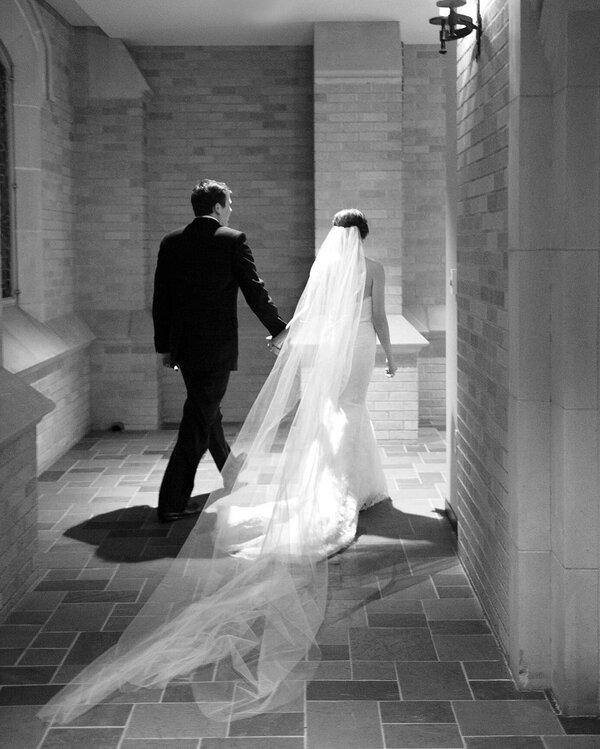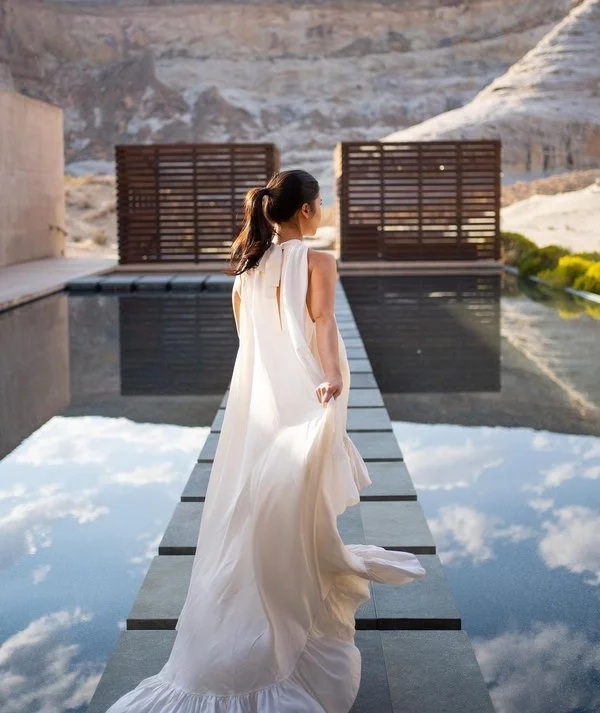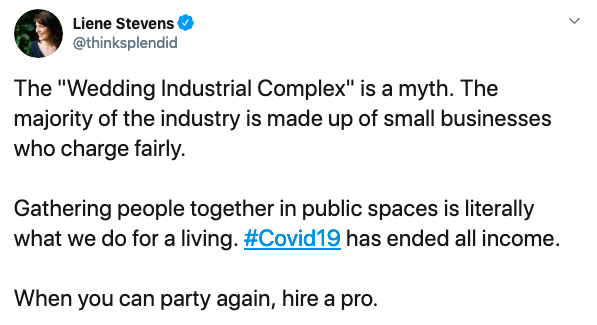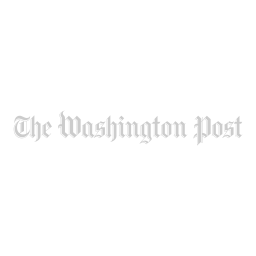How percentage pricing works and when it doesn’t make sense to use it.
Photo by Cameron Clark.
Wedding Pricing: The Percentage Model
If you’ve known me for more than 20 minutes – either through meeting in person, seeing me speak, reading this blog, or working with me – you know that I firmly believe that every decision we make and strategy we create needs to be rooted in a place of authentic optimism rather than uninformed positivity.
Authentic optimism says, “This is hard, but we will get through this, and we will get through it together.”
In the case of COVID-19’s impact on business, authentic optimism considers the facts as presented by scientists and doctors and charts a course that can be constantly updated as we receive new information.
Uninformed positivity, on the other hand, says things that stem solely from wishful thinking rather than reality, such as, “This will be ancient history by Summer!” and will have us making business decisions that ultimately do more harm than good.
Practicing authentic optimism is one of my company’s core values. My job as a wedding business consultant is to think through and solve complex problems. It’s my favorite thing to do (I made my peace with being a nerd a long time ago) and I approach each issue with the belief that every situation is redeemable and that we repeat what we don’t repair. We can’t make healthy adjustments until we acknowledge reality.
One of the topics I have been thinking through from various angles recently is pricing and how most strategies that wedding pros use will have to be temporarily adjusted because of COVID-19 – recession or no recession.
Last week I was a guest on my friend Renee Dalo’s podcast, where we talked all about wedding pricing strategies in a pandemic.
My episode will be released soon, and to get the most out of what I have to say, I recommend first listening to the previous episode with Michelle Loretta on managing finances. Pricing is predicated on knowing your costs and understanding how to handle the money coming in and out of your business. Michelle’s insights will help you get organized in that regard so that you can tackle your pandemic pricing strategy from an informed place.
While Renée and I covered a lot of ground, one area we chatted more extensively about was the percentage model.
I want to talk about this model specifically – and more than once – because I see a lot of luxury wedding planners and event designers making assumptions about weddings after quarantine that don’t ring true with what we know about coronavirus and the long path we are on to get it under control.
UNINFORMED ASSUMPTIONS vs EDUCATED GUESSES
The main assumption I’m seeing wedding pros make is that when things reopen, they’ll reopen to how they were before. That, because of the economic impact, we’ll see more people opting for smaller weddings in order to save money but that most couples will still get to celebrate with the usual 250+ guests.
The first part of this assumption is true: there will be couples who choose to save money by celebrating only with their nearest and dearest.
I’m not at all convinced about the second part.
While we don’t know anything for sure, we can use the facts we have to make educated guesses.
Economic recession aside, it is highly unlikely that we will be back to “normal” guest counts until there is a vaccine.
When weddings and events are allowed to happen again, we should be prepared for our respective local governments to limit them to 50, 75, maybe 100 people.
Given what we know about how coronavirus spreads, including through asymptomatic carriers who don’t feel a thing or even know they have it – and that it is yet to be proven that once you’ve recovered from it you can’t get it again (plenty of viruses return after laying dormant for years) – it is not a stretch to make an educated guess that some type of event size limitations will be in place while the vaccine is being tested.
We also know that the stay home orders were designed to slow the spread so that our healthcare systems wouldn’t be overwhelmed and more lives could be saved. Quarantine was never a cure in and of itself – it was designed to make the problem less worse (and it has).
If we immediately reopen fully to how things were before, we will see a second wave and we’ll be back in lockdown. Most government leaders are trying to avoid that scenario. Again, we can use these facts to make an educated guess that we will have to follow different capacity guidelines when we go back to work.
This means that the idea that you can use your typical wedding pricing strategy and charge your usual rates or minimums is nice in theory but not at all grounded in reality.
UNDERSTANDING PERCENTAGE PRICING
If event size limitations go into effect until there is a vaccine, the wedding professionals who will be impacted the most will be those who sell on consumption and volume (caterers, rental companies, florals, etc), those who host wedding expos or b2b wedding conferences, and planners and event designers who use a percentage pricing model.
Today I want to focus on those of you who charge percentage.
So we’re all on the same page, here’s how the percentage pricing model tends to work in the wedding industry:
The wedding planner or designer’s fee is based on a percentage of the overall budget of the event elements they manage.
This means they’re not getting a cut of the $10,000 Vera Wang dress, etc.18% is the wedding industry standard in North America, Europe, Latin America, and Australia. The Philippines, Indonesia, and India are 10-15%. Kenya, Ghana, and South Africa tend to average about 15%, in Nigeria it is 20%.
Some wedding planners charge more, some less, but this is generally where the numbers fall for those who charge percentage.There is usually a minimum wedding budget amount so that the planner or designer can determine if the wedding will generate enough revenue to be worth their company’s time.
Example: 18% with a $100,000 minimum wedding budget = $18,000 planning fee.
This $18,000 is, of course, gross revenue. It goes into the business to cover employee payroll, taxes, insurance, studio lease, utilities, marketing, etc. It does not go straight into the wedding planner’s pocket as pure salary.
There are various ways to configure the minimums, but for the sake of simplicity and round numbers this is the gist of how it works.Sometimes the percentage is calculated behind the scenes and presented as a flat fee to the client.
This method can help the client feel more comfortable and ensures the planner is still getting paid fairly for the amount of work they and their team are doing.
The common argument against percentage pricing is that it’s not fair to the brides and grooms because the wedding planner or designer is incentivized to spend more even though the amount of work is the same. This argument is usually made by an uninformed client or an industry rookie.
The level of work is not the same and while there are a few bad apples who take advantage, most of the wedding pros using this model provide a transparent, itemized accounting of their wedding budget spending to their clients.
If you’re only doing ballroom weddings at a few specific hotels or working at a venue that consistently maintains their outdoor spaces for events, then maybe your process can be a bit more turnkey because there are rarely any surprises. In that case, the percentage model may not be a good fit for you.
Percentage pricing works well for complex events with a lot of moving pieces and additional legwork on your part:
You learn during a site inspection that the ground has to be graded in order to properly install the tent and your role as wedding planner now includes overseeing a landscape architect and her team.
Heads of state are on the wedding guest list and require additional security considerations.
Your client opted for a destination wedding on a private island and you need to work with a customs broker to get your decor rentals, florals, and every piece of catering equipment delivered to the main island and then trucked to the opposite end and put on a ferry to the private island.
There are a lot of reasons that percentage pricing is fair, and even if your wedding does not require super complicated logistics, higher guest counts still require more work on your end: more time spent on room layouts and seating charts, more staff to oversee during install, more pieces of decor and rentals that have to be produced and perfectly placed.
Percentage pricing ensures you get paid for that additional work.
PERCENTAGE PRICING IN A PANDEMIC
Here’s where it gets tricky: If you use the percentage pricing model, and if for the next several months weddings are limited to 50 guests, it will be more difficult to hit your break-even revenue numbers (never mind profitability).
Your standard budget minimums that are typically based on a per person cost of a 200 guest wedding won’t be applicable if only 50 guests are allowed to attend.
Recession or no recession, wedding spending is still going to be proportional to the amount of guests and if the mandated number of guests is less, then spending will be less.
If your clients can afford it, they may be willing to spend somewhat more on their 50 person wedding to give their guests a more pampered experience, but they are not going to quadruple their spend per guest just to hit your normal minimum.
A few wedding planners may land clients willing to do this or you may have religious or multi-cultural clients who still choose to have their standard 800 guests, but split them into multiple celebrations over multiple weekends. These types of scenarios will be the exception to the rule. Part of being authentically optimistic is working under the mindset that you are exceptional, but you are NOT the exception.
Let’s break it down further and look at the math:
If you have a wedding with 50 guests that would normally be 200:
That’s only five 10-top tables instead of 20.
That’s 15 fewer centerpieces.
15 fewer table linens.
150 fewer place settings.
150 fewer custom menu cards
150 fewer chairs.
It’s a smaller tent, and even if your client still splurges on floral to create a dramatic entrance or ceiling installation, it’s still fewer flowers because you’re covering less square footage.
It’s less time to prep and treat the florals, it’s less time to install, it’s less to manage.
And since your percentage is based on what you manage, you’re making less.
Your labor costs may be lower because you won’t need as much help on installation, but you’re now managing less, so the revenue from your percentage is less.
Granted, you may now have extra things to manage you never thought about before: in some regions, you’ll be required to take guests’ temperatures at the entrance before they’re allowed in.
This area will require not only additional staff to administer the temperature checks but also additional decor since you’ll want this area to be beautiful and welcoming and not cold and clinical. You’re still setting the tone for a fun, personable, gracious experience, even though you’ll have to follow stricter regulations.
You may decide to add more bars to the floor plan so there’s less crowding, or you may decide all drink orders will be taken person by person, table by table. You’ll need more event staff to handle that.
You may now need to design custom masks for guests to match the custom kippot you already had planned.
These are expenses and costs that can fall under your percentage fee. Managing these new elements is additional work for you and you should be paid for it. When you create your budgets for your clients, these “new normal” line items will need to be included.
GETTING PAID FOR YOUR CREATIVE IDEAS
When volume is temporarily limited by law, percentage pricing can be a liability if you're not also getting paid for your ideas.
Whatever pricing you present to your couples should include a creative fee, whether it’s rolled into the total or billed separately.
The creative fee – sometimes called a design fee – is where you get paid for the ideas in your head regardless of the logistics of production and execution.
Your design vision, taste, style, expertise, and experience all hold value that can’t be commoditized. A creative fee is not dependent on the number of guests or staffing labor costs or how much a client spends on flowers or entertainment.
While you should be getting paid for your creative ideas when times are normal, you should especially be getting paid for them now.
DON’T PANIC BUT DO OVERPREPARE
Again, we are operating by making educated guesses rather than uninformed assumptions.
None of us have a crystal ball, and I could be (and truly hope I am!) completely wrong on these predictions.
Maybe when the ban is lifted we’ll go back to the only guest count limitations being venue capacity and the previous laws set by the fire marshall.
If that’s the case – and you’ve prepared your business for more stringent regulations – you’ll still be in a good position because you’ll be able to pivot back to how you normally run things.
If I’m right though about guest counts being limited until there’s a vaccine, and you didn’t think through how to adjust your wedding pricing to hit your needed revenue based on a few different potential scenarios, you will be left scrambling and losing weddings to your colleagues who took this time to better prepare.
It’s better to be authentically optimistic and overprepare than to panic and shut out any uncomfortable thoughts of change.
FIGHTING FOR YOUR BABY
No matter the business strategies you choose, there will be people who disagree. We’re already seeing wedding pros be extra loud in Facebook groups about the ways their competitors are choosing to pivot and support their families right now.
If you’ve thought through your options and made plans based on educated guesses backed by the scientific facts we currently know, then you can pay the naysayers no mind.
Unless the person who disagrees is someone you trust to point out a blind spot in good faith and help you figure out a better solution, their opinions are irrelevant. They’re not paying your bills.
You can think of your business like a child in the sense that what it needs as a newborn is different than what it needs as a toddler which is different than what it needs as a tween which is different than what it needs as a teenager. Each year of maturity comes with its own set of challenges and joys.
Similarly, the approach you took for your business when you started is different than the one you may be taking now at year 10, 15, 20, 25. Each level of success comes with its own set of challenges and joys.
That said, no matter the age of your child, they are always your baby: when an emergency happens, you drop everything, normal life goes out the window, your priorities shift, and your entire focus is on keeping your baby alive.
The event industry especially is in an emergency phase right now. Our current focus is not on profitability but on breaking even so that we can keep our businesses afloat.
You fight for your literal child’s survival. You fight for your company’s survival.
Saving your business by temporarily putting your normal routine on hold and making adjustments based on new realities is a valid choice to make.
Don’t let anyone tell you it’s not.
Written by
LIENE STEVENS
Liene Stevens, the founder and CEO of Think Splendid, is an author, speaker, and award-winning business strategist. Armed with $2000, a healthy work ethic, and an undeserved dose of privilege, Liene bootstrapped Think Splendid from a scribble in a notebook to a successful wedding business consulting firm with a client list spanning 94 countries.























